Understanding the Significance of Early and Ongoing Mental Health Detection
Mental health screening is a cornerstone of effective substance abuse treatment, providing the essential opportunity for early detection, comprehensive diagnosis, and personalized intervention. Given the high prevalence of co-occurring mental health and substance use disorders—affecting about 50% of individuals with addiction—systematic screening ensures that underlying psychological conditions are identified and addressed alongside substance-related issues. This holistic approach enhances the likelihood of successful recovery, reduces relapse rates, and improves overall well-being. This article explores why mental health screening is vital in the context of substance use disorder treatment, the tools involved, and how it facilitates better treatment planning and recovery outcomes.
Why Mental Health Screening Is Fundamental to Recovery
Why are mental health screenings important?
Mental health screenings are essential tools in the journey to effective recovery from substance use and mental health disorders. They enable early detection and intervention, which are critical for improving long-term outcomes.
Many mental health issues, such as depression, anxiety, and post-traumatic stress disorder (PTSD), often develop early in life; studies indicate that approximately 50% of mental health conditions begin by age 14, and 75% by age 24. When these issues are identified promptly through screening, individuals can receive appropriate treatment before conditions worsen.
Screenings are particularly vital in primary care settings, schools, and community programs where many young people and adults first seek help. These brief assessments help bridge the significant gap in mental health services, especially considering that a large proportion of youth and adults with mental health needs do not receive the care they require.
Early detection through systematic screenings can lead to targeted, personalized interventions, preventing the progression of illness, and reducing the risk of long-term disabilities. For instance, untreated depression or anxiety can impair schooling, employment, and social relationships, while increasing the risk of substance misuse and suicidal behaviors.
Moreover, mental health screenings can unveil underlying issues such as trauma, interpersonal violence, or substance use behaviors that might otherwise go unnoticed. Recognizing co-occurring mental health and substance use disorders allows for integrated treatment approaches, which are proven to be more effective.
Prevention is another major benefit. By catching mental health concerns early, healthcare providers can implement strategies that prevent the development of severe symptoms or comorbid conditions. This proactive approach ultimately reduces the societal and economic costs associated with untreated mental illness, including hospitalizations, legal problems, and loss of productivity.
In summary, mental health screenings are a foundational element in fostering recovery. They not only help in early diagnosis but also facilitate timely and comprehensive treatment, which greatly enhances the chances of long-term recovery and improved quality of life.
Benefits of Early Detection and Intervention
Early detection through mental health screening offers a window of opportunity to intervene before conditions become chronic or debilitating. It allows clinicians to develop effective treatment plans tailored to individual needs, combining therapies such as counseling, medication, and lifestyle modifications.
Intervening early can also alleviate symptoms more rapidly, reducing suffering and improving functional outcomes. For adolescents and young adults, timely screening can prevent school failure, social withdrawal, and the development of entrenched mental health patterns.
Furthermore, early intervention reduces the likelihood of substance misuse as a coping mechanism, thereby preventing the escalation to dependency or addiction. This proactive approach results in less intensive and less costly treatments in the long run.
Recognizing and Managing Co-Occurring Disorders
Many individuals seeking help for substance use problems are also battling underlying mental health issues. Around 50% of those with addiction have a concurrent mental disorder such as depression, anxiety, or bipolar disorder.
Screening helps identify these co-occurring conditions early, which is vital since symptoms often overlap or mask each other. Integrated treatment plans that address both mental health and substance use are more effective than treating each separately.
Professional assessments guided by validated tools like the Patient Health Questionnaire-9 (PHQ-9) and the Addiction Severity Index (ASI) ensure accurate diagnosis. Addressing both issues simultaneously can lead to better health outcomes, fewer relapses, and an overall improvement in daily functioning.
Prevention of Long-term Disabilities and Relapses
Untreated mental health disorders can lead to chronic disabilities, reduce quality of life, and increase the risk of relapse in substance use. Lifelong disabilities such as unemployment, social isolation, or legal troubles often stem from unrecognized or unmanaged mental health conditions.
Regular screening fosters early recognition, minimizing these long-term consequences. It encourages ongoing assessment, enabling adjustments in treatment plans to adapt to changing needs.
In the context of substance use, early mental health intervention diminishes the likelihood of relapse, especially when combined with ongoing support and therapy. It also empowers individuals to develop resilience, better emotional regulation, and coping strategies.
Overall, integrating mental health screening into addiction treatment is crucial for sustained recovery, reducing the risk of recurrence, and promoting a healthier, more productive life.
| Aspect | Explanation | Additional Details |
|---|---|---|
| Early detection | Identifies issues before they worsen | Critical for timely intervention in youth and adults |
| Co-occurring disorders | Recognizes dual diagnosis | Facilitates integrated treatment approaches |
| Long-term prevention | Reduces disabilities and relapses | Encourages ongoing screening and assessment |
| Population focus | All ages and settings | Schools, clinics, workplaces, community programs |
| Screening tools | Validated instruments | PHQ-9, ASI, CAGE, AUDIT, and others |
| Benefits | Improved health outcomes | Less societal and economic burden |
By prioritizing mental health screening, healthcare providers can foster a proactive, comprehensive approach to recovery, helping individuals lead healthier, more fulfilling lives.
Understanding Co-occurring Disorders and Their Treatment
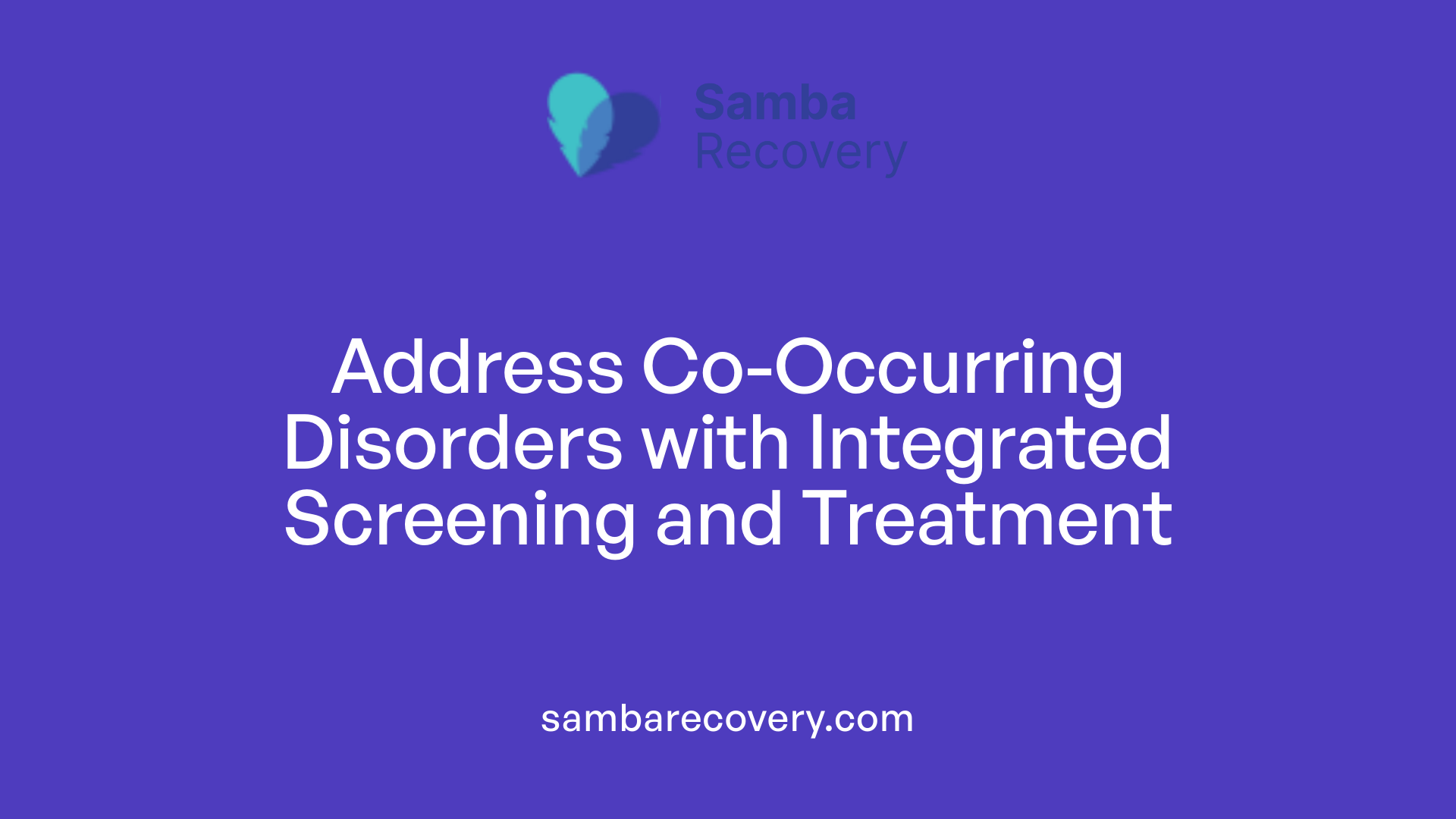
What is the prevalence of co-occurring mental health and substance use disorders?
Co-occurring disorders, also known as dual diagnosis, are highly common among individuals seeking treatment for substance use issues. Research indicates that approximately 50% of people with addiction also experience a mental health disorder at some point in their lives. This overlapping presence means many individuals struggle with both addiction and mental health conditions like depression, anxiety, post-traumatic stress disorder (PTSD), bipolar disorder, and schizophrenia.
Serious mental illnesses, such as major depression, schizophrenia, and bipolar disorder, are found in about 1.4% of adults with substance use disorders. Many individuals with co-occurring conditions have histories of trauma, sexual victimization, or interpersonal violence, further complicating their treatment needs. Recognizing the widespread nature of these overlapping issues underscores the importance of comprehensive screening and assessment processes to ensure accurate diagnosis and effective treatment planning.
Why is the diagnosis and treatment of both conditions simultaneously important?
Simultaneous diagnosis and treatment are crucial because treating one disorder without addressing the other often leads to poorer outcomes. If a mental health disorder remains undiagnosed, it can significantly hinder recovery from substance misuse, increasing the risk of relapse and treatment failure.
Integrated treatment approaches that address both mental health and substance use issues at the same time are considered more effective than sequential or separate treatments. They help in managing symptoms more efficiently, reducing the overall severity of both conditions, and promoting sustained recovery.
Failing to diagnose or treat co-occurring disorders properly can lead to a cycle of worsening mental health and escalating substance use, putting individuals at risk for hospitalization, legal issues, and deteriorating social relationships. Therefore, comprehensive screening and assessment are the first critical steps in identifying underlying issues and developing tailored, effective interventions.
How do integrated treatment approaches improve outcomes?
Integrated treatment involves coordinated care from mental health professionals and addiction specialists working together within a unified framework. This approach can incorporate various therapies such as cognitive-behavioral therapy (CBT), motivational enhancement, medication management, and family support — all tailored to the individual’s specific conditions.
Studies have shown that integrated care results in better health outcomes, including reduced symptoms, lower relapse rates, and improved daily functioning. Patients engaged in integrated programs often experience less stigma and feel more supported, which enhances treatment adherence.
Furthermore, addressing both issues simultaneously helps individuals develop healthier coping mechanisms, better emotional regulation, and more effective problem-solving skills. This comprehensive method not only expedites recovery but also reduces the hospitalization and long-term healthcare costs associated with untreated co-occurring disorders.
How does mental health screening influence treatment planning and success?
Mental health screening plays a vital role in treatment planning and success by enabling early identification of mental health issues such as depression, anxiety, and bipolar disorder, often before symptoms become severe. These screenings help healthcare providers develop personalized treatment plans tailored to the individual’s specific needs, including therapy, medication, lifestyle changes, or digital interventions.
They also foster greater self-awareness in clients, encourage early intervention, and reduce stigma associated with mental health concerns. Regular screening and reassessment ensure that treatment remains responsive to changing circumstances, improving long-term outcomes.
Ultimately, mental health screening enhances the effectiveness of interventions, facilitates better resource allocation, and supports sustained recovery.
How does understanding the interaction between mental health and substance use shape treatment?
A thorough understanding of how substance use disorders and mental health issues interact is essential for accurate diagnosis and effective treatment. Many people develop substance misuse as a way to self-medicate psychological symptoms or due to shared risk factors such as trauma or genetic predisposition.
Recognizing this interaction guides clinicians to develop integrated treatment plans that simultaneously target both conditions. This holistic approach improves the likelihood of treatment engagement, reduces symptoms more effectively, and prevents the cycle of worsening mental health and substance use.
Proper assessment tools like the Addiction Severity Index (ASI), DSM-5 structured interviews (SCID-5), and standardized questionnaires such as PHQ-9 or the Beck Depression Inventory enable clinicians to gather comprehensive information. These facilitate precise diagnosis, appropriate intervention, and better health outcomes.
What are the benefits of screening and assessment in addressing co-occurring disorders?
Screening and assessment serve as foundational components in identifying individuals with co-occurring disorders. They help in early detection, which is crucial for initiating timely treatment and improving prognosis.
Screening involves brief questionnaires or interviews that can be administered quickly during routine visits, while assessments provide detailed information about the severity, psychological factors, social dynamics, and biological influences.
Using standardized and validated tools ensures the accuracy and reliability of these evaluations across different populations. Incorporating cultural, social, and psychological considerations enhances personalized care.
These processes not only aid in establishing comprehensive treatment plans but also contribute to public health by reducing substance-related accidents, crimes, and hospitalization costs.
What approaches support effective care for individuals with co-occurring conditions?
Effective care combines screening, assessment, and integrated treatment strategies. It involves a team-based approach where addiction specialists, mental health clinicians, social workers, and primary care providers collaborate.
The use of evidence-based therapies such as Cognitive Behavioral Therapy (CBT), Motivational Interviewing, and pharmacotherapy tailored for both mental health and substance use issues has proven beneficial.
Furthermore, ongoing monitoring through repeated screenings ensures that treatment remains aligned with the client’s evolving needs. The implementation of models like the Collaborative Care Model emphasizes coordinated, patient-centered care that enhances engagement and recovery.
Innovations such as telehealth platforms, online screening tools, and community-based programs extend access to essential services, especially in underserved populations.
Understanding the importance of early detection and sustained management
Early detection through screening allows for timely interventions which can prevent the escalation of symptoms, limit the development of chronic conditions, and improve overall life quality.
Sustained management includes continuous monitoring, reassessment, and adaptation of treatment strategies based on progress and changes in circumstances. It reduces long-term health costs and enhances the individual’s capacity to function effectively in daily life.
By proactively addressing co-occurring disorders, healthcare systems can significantly improve recovery outcomes, reduce relapse rates, and promote healthier, more resilient communities.
| Topic | Purpose | Tools/Strategies | Outcome | Additional Notes |
|---|---|---|---|---|
| Prevalence of co-occurring disorders | Highlight how common dual diagnosis is | Epidemiological data, surveys | Justifies need for screening | Approximately 50% of those with addiction experience mental health issues |
| Importance of diagnosis | Ensure accurate and effective treatment | Screening, assessment, validated tools | Better recovery rates, reduced relapse | Simultaneous diagnosis improves outcomes |
| Integrated treatment | Address both disorders together | CBT, medications, team approach | Higher treatment adherence and success | Reduces stigma and barriers |
| Role of mental health screening | Early detection and personalized planning | Questionnaires, interviews | Enhanced intervention effectiveness | Regular reassessment is crucial |
| Interaction between disorders | Guide comprehensive care | Holistic evaluation, understanding shared symptoms | Improved diagnosis and tailored interventions | Critical for effective treatment planning |
| Supporting care approaches | Improve access and outcomes | Community programs, telehealth, evidence-based therapies | Better health results and reduced costs | Ongoing monitoring enhances success |
| Early detection benefits | Prevent escalation | Brief screening tools, biomarkers | Increased recovery chances | Timely intervention saves resources |
| Sustained management | Maintain progress | Continuous screening, adaptive treatment plans | Long-term recovery and reduced relapse | Case management importance |
Understanding and addressing co-occurring mental health and substance use disorders require comprehensive approaches centered around early detection, accurate diagnosis, and integrated treatment. Regular screening and assessment are fundamental in identifying issues promptly and tailoring interventions effectively, ultimately improving individual health and societal well-being.
Tools and Methods Used in Mental Health Screening
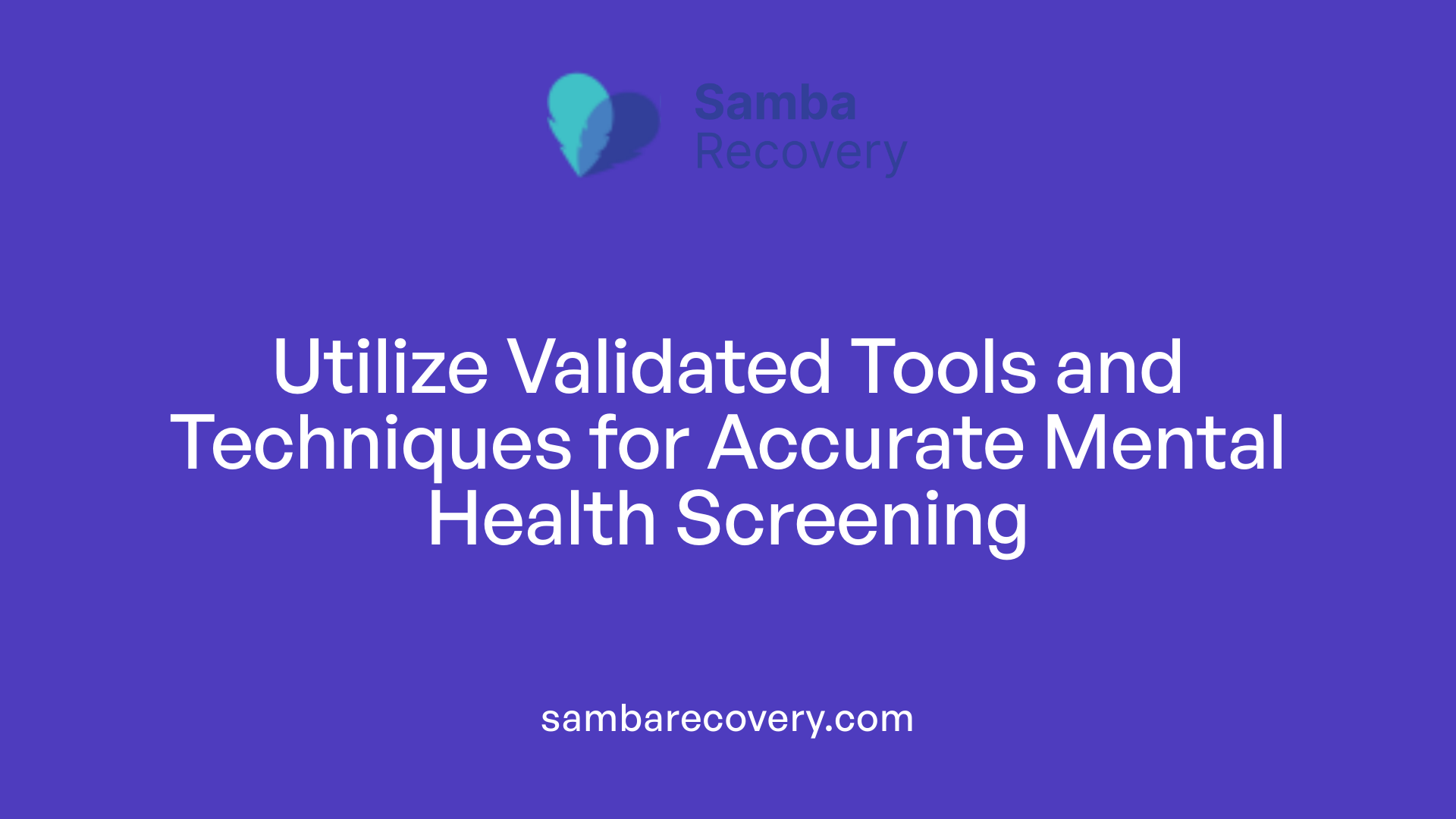
What assessment tools are used for mental health and substance use disorder screening?
Assessment of mental health and substance use issues involves various standardized questionnaires, clinical interviews, and specialized screening instruments. These tools are designed to identify potential problems early and guide appropriate intervention.
Many of these instruments are validated for specific populations, such as adolescents, adults, older adults, pregnant women, and healthcare professionals, ensuring that assessments are accurate and relevant. For substance use disorders, common screening tools include the Substance Use Screening Inventory (S2BI), Brief Screen for Tobacco, Alcohol, and other Drugs (BSTAD), Triage Alcohol, Tobacco, and Other Drugs (TAPS), Drug Abuse Screening Test (DAST-10), Alcohol Use Disorders Identification Test (AUDIT and AUDIT-C), Alcohol, Smoking and Substance Involvement Screening Test (ASSIST), Cannabis Use Disorder Identification Test-Revised (CUDIT-R), CRAFFT (for adolescents), and the NMASSIST.
These tools can be administered either through self-report questionnaires or by clinicians during interviews, depending on the setting and the individual’s needs. Self-administered questionnaires are often quick and effective, facilitating early detection during routine visits.
In addition to questionnaires, healthcare providers may perform structured clinical interviews, such as the Structured Clinical Interview for DSM-5 (SCID), which offer a detailed evaluation of mental health and substance use disorders for accurate diagnosis.
Biomarkers, such as blood tests, urine analysis, and saliva testing, can also serve as objective measures of recent substance use, especially when self-reporting is unreliable. These tests typically detect recent drug use within 72 hours, with marijuana detectable for up to 30 days.
Patient reports and observations are equally vital, helping to identify behavioral and psychological signs that may not be captured through questionnaires alone.
Screening for safety risks related to intoxication and withdrawal is critical. Specific scales like the Clinical Institute Withdrawal Assessment (CIWA) help evaluate the severity of withdrawal symptoms. Screening for trauma, especially in women and individuals with histories of sexual victimization or interpersonal violence, also informs treatment planning, given the high prevalence of trauma history in this population.
Furthermore, screening for associated conditions such as eating disorders—which possess high mortality rates—is recommended. Tools like the EAT-26 aid in identifying risk.
Overall, employing a combination of validated questionnaires, clinical assessments, biomarkers, and behavioral observations provides a comprehensive picture of an individual’s mental health and substance use status. This multi-method approach enhances the accuracy of diagnoses and the effectiveness of subsequent treatments, ensuring that individuals receive tailored care suited to their specific circumstances.
| Tool Type | Examples | Purpose/Population | Additional Details |
|---|---|---|---|
| Standardized Questionnaires | AUDIT, CAGE, DAST-10, TAPS, CRAFFT, NMASSIST | Detecting substance use, alcohol, and drug problems | Self-report or clinician-administered; validated for specific populations |
| Clinical Interviews | SCID, structured clinical interviews | Confirm diagnosis, detailed assessment | Require trained professionals; provide comprehensive insights |
| Biomarkers | Urinalysis, blood tests, saliva tests | Objective recent substance use detection | Detect drugs within 72 hours; marijuana up to 30 days |
| Behavioral Observations | Mood swings, behavioral changes | Identify signs not captured by questionnaires | Used during clinical evaluation; essential for trauma screening |
| Safety and Withdrawal Scales | CIWA, Specialized trauma screening tools | Assess withdrawal severity and trauma history | Guide medical management; inform trauma-informed approach |
Choosing the appropriate assessment tools depends on factors such as ease of use, validity, cultural appropriateness, and the specific population being assessed. Combining these methods ensures a thorough evaluation, leading to accurate diagnosis and tailored treatment plans.
The Connection Between Mental Health and Recovery Outcomes
How does integrated treatment improve recovery outcomes?
Integrated treatment enhances recovery success by simultaneously addressing both mental health and substance use disorders, which frequently occur together. These conditions can feed into each other, making recovery more challenging if only one aspect is treated.
This approach employs various therapies and strategies, such as psychotherapy, medication management, motivational interviewing, and family therapy, to create a comprehensive care plan. By doing so, therapists can target the root causes and interconnected symptoms more effectively.
An interdisciplinary team—including mental health professionals, addiction specialists, social workers, and primary care providers—coordinates care to ensure all aspects of a patient’s health are managed. This teamwork improves adherence to treatment, facilitates smoother discharge planning, and enhances community and social support.
Evidence indicates that patients engaged in integrated treatment often experience higher motivation and better engagement with their recovery process. This can lead to improved behavioral health, decreased relapse rates, and sustained abstinence.
Holistically addressing mental health and substance issues results in more stable and long-lasting recovery, lessening the likelihood of hospital readmissions and contributing to overall well-being. In conclusion, integrated treatment solutions are key to achieving positive, durable outcomes for individuals dealing with co-occurring disorders.
The Impact of Screening on Treatment and Relapse Prevention
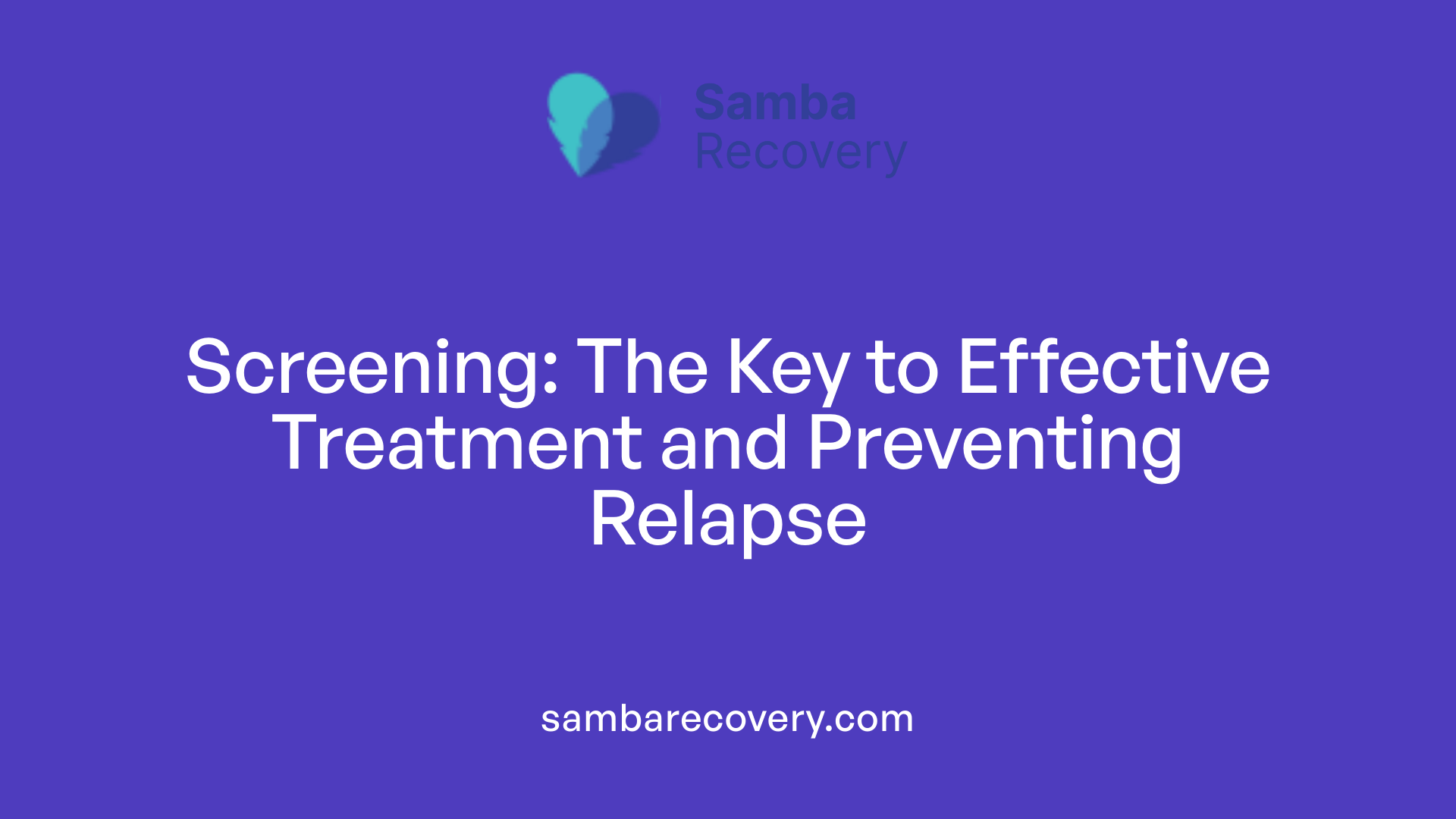
Why is screening and assessment vital for treating addictive behaviors?
Screening and assessment are foundational components in the effective management of substance use disorders. They serve as the first step in identifying individuals at risk or currently experiencing substance-related problems, often before the issues become severe. Early detection facilitates timely intervention, which can significantly reduce health complications, legal issues, and social consequences.
Screening tools help differentiate casual substance users from those with more serious use patterns that require more intensive treatment. They can reveal underlying co-occurring mental health conditions, trauma histories, and social factors that influence substance use, enabling comprehensive and personalized treatment planning.
Assessment takes this further by providing a detailed understanding of an individual’s unique circumstances. It evaluates physical health, mental health, social environment, and behavioral patterns. This thorough approach helps clinicians design tailored interventions that address specific needs, increasing the likelihood of successful recovery.
Ongoing assessments are crucial even after treatment commences. They enable clinicians to monitor progress, detect potential setbacks early, and modify treatments accordingly. This dynamic process supports sustained recovery by promoting adjustments in therapy, medication, and support strategies.
Moreover, assessments often involve family, peers, and support systems, fostering a supportive environment that can bolster resilience. Recognizing the multifaceted aspects of addiction through assessment enhances the overall effectiveness of intervention and treatment outcomes.
The Role of Routine Screening in Preventive Care
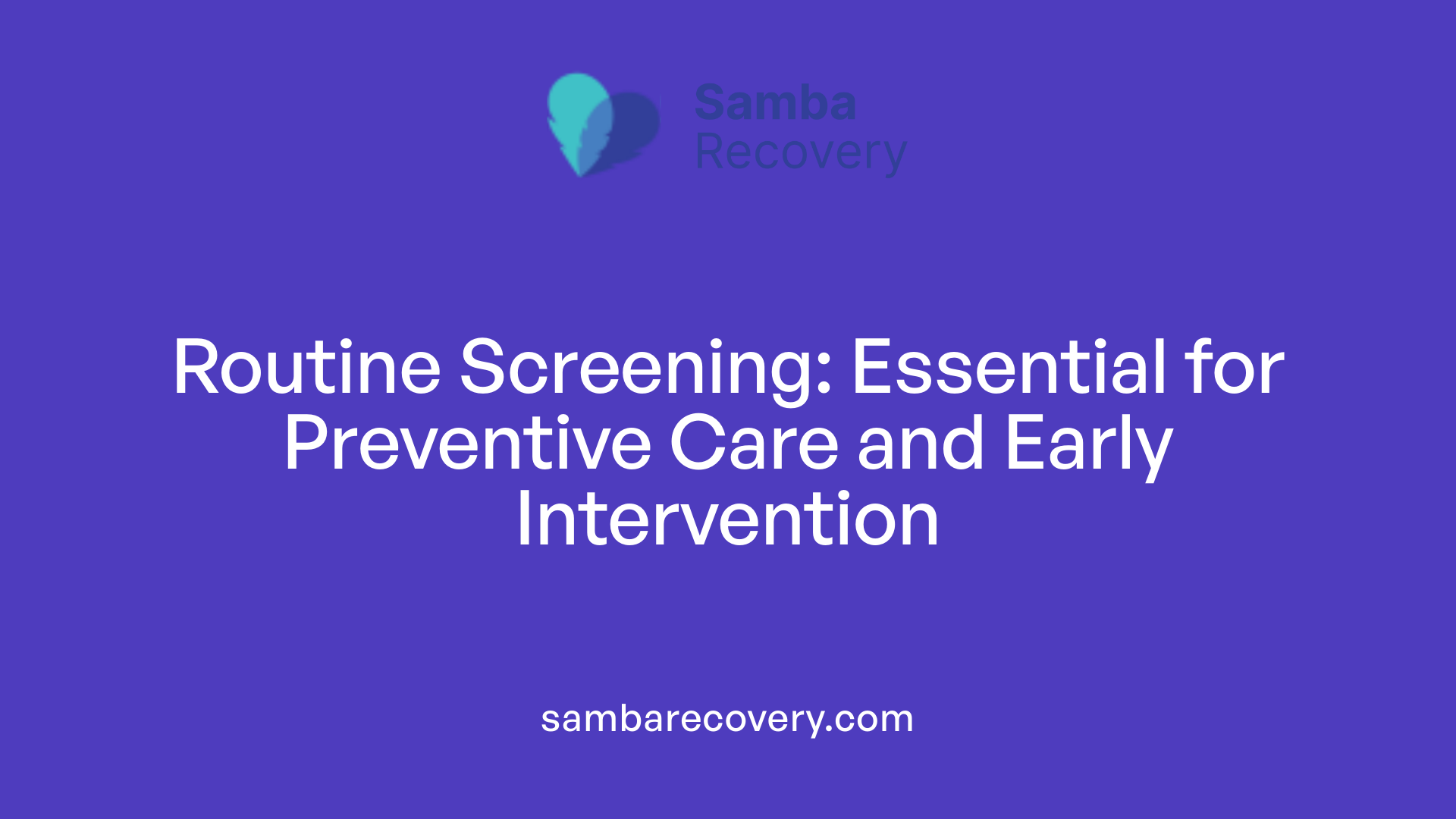
Why is screening and assessment vital for treating addictive behaviors?
Screening and assessment are crucial components in addressing addiction because they serve as the first step toward early detection. These processes enable healthcare providers to identify substance use problems before they develop into more severe health or social issues. By differentiating between casual users and individuals with problematic substance use, clinicians can tailor their responses appropriately.
Comprehensive assessments go beyond simple screening questions, delving into the medical, psychological, social, and contextual factors contributing to substance use. This thorough evaluation helps develop personalized treatment plans that increase the likelihood of successful recovery. Additionally, ongoing monitoring through repeated assessments allows clinicians to track progress, adjust interventions, and reinforce long-term sobriety.
Involvement of family members or support systems during assessment can foster a more supportive environment, which is essential for sustained recovery. Overall, screening and assessment are indispensable tools for early intervention, effective treatment planning, and improving long-term outcomes in substance abuse treatment.
Conclusion: Promoting a Culture of Mental Health Awareness and Early Intervention
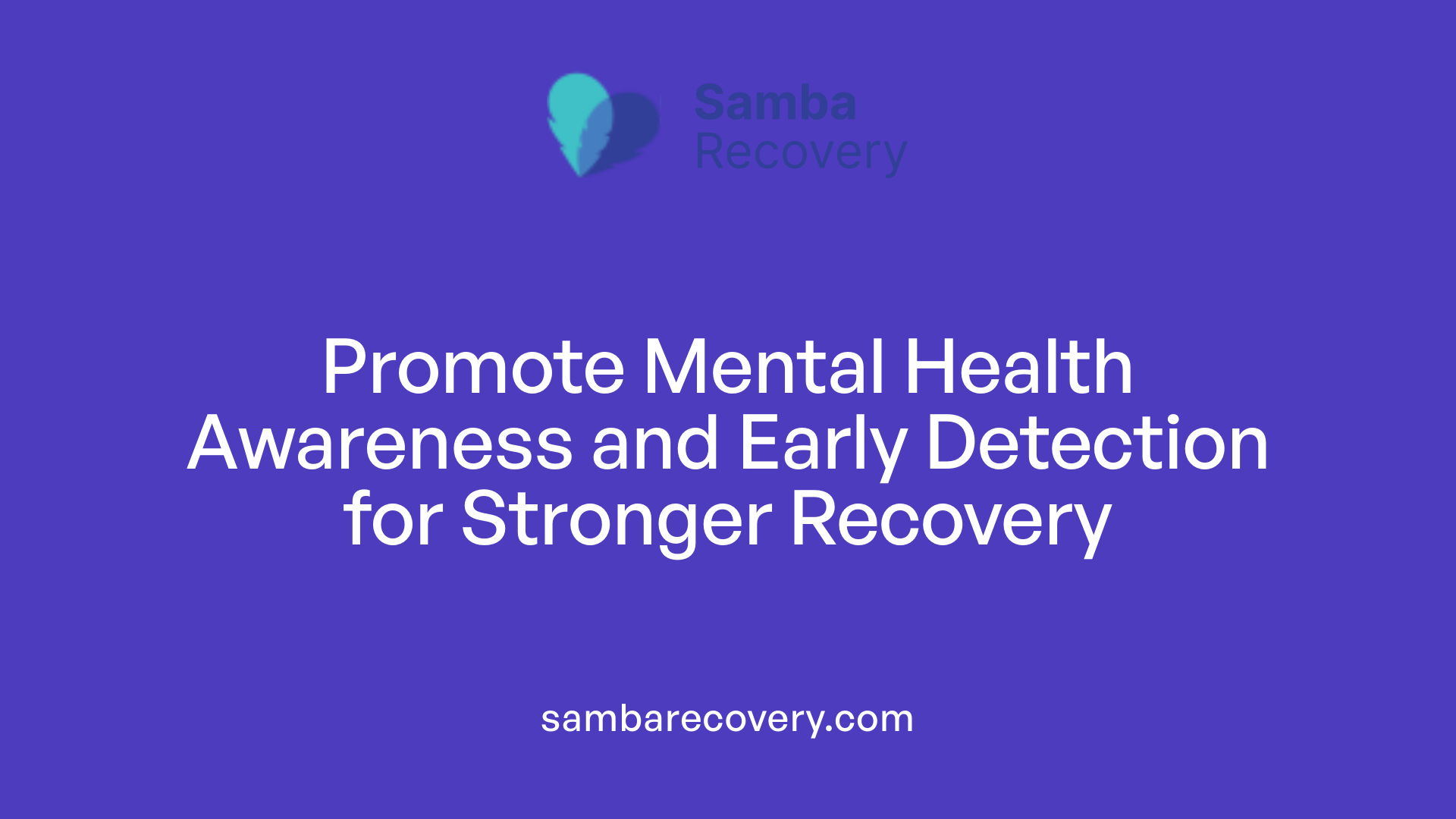
Establishing a culture that prioritizes mental health awareness and early detection is essential for effective substance abuse prevention and treatment. Universal screening plays a crucial role in destigmatizing mental health issues by normalizing conversations around alcohol, drug use, and emotional well-being. When screening becomes a routine part of healthcare, individuals are more likely to seek help without fear of judgment.
Enhancing community resources, including accessible mental health services and educational programs, supports early identification and intervention. Community-based initiatives, such as workshops, outreach programs, and integrated health services, help bridge gaps in care and ensure that diverse populations receive appropriate attention.
Fostering holistic recovery approaches that combine mental health treatment, substance use counseling, and social support leads to better outcomes. Emphasizing a comprehensive strategy recognizes the interconnectedness of mental health and substance use, promoting sustained recovery and improved quality of life.
By integrating these strategies, we can build a supportive environment that emphasizes prevention, reduces stigma, and encourages early engagement—ultimately saving lives and strengthening community health.
The Path Forward: Embracing Systematic Mental Health Screening for Better Outcomes
Incorporating routine and comprehensive mental health screening into substance abuse treatment settings is essential for effective recovery. Not only does it facilitate early detection of mental health disorders and co-occurring issues, but it also guides personalized and integrated treatment plans. As research underscores, early intervention can significantly reduce relapse rates, improve long-term health, and foster resilience. Promoting widespread awareness, destigmatizing mental health problems, and ensuring access to validated assessment tools are integral to creating a healthcare environment that prioritizes mental well-being alongside physical health. Embracing a culture where mental health screening is routine in all healthcare interactions will lead to healthier individuals and safer communities, ultimately paving the way for more successful substance abuse recovery.
References
- Chapter 2—Screening for Substance Use Disorders – NCBI
- 4 Screening and Assessment – Substance Abuse Treatment – NCBI
- Screening, Brief Intervention, and Referral to Treatment (SBIRT)
- Screening and Assessment of Co-Occurring Disorders
- Screening | Columbia University Department of Psychiatry
- Why Mental Health Screening is a Crucial Preventive Care Step
- Mental Health’s Role in Addiction and Recovery | University of Utah …






